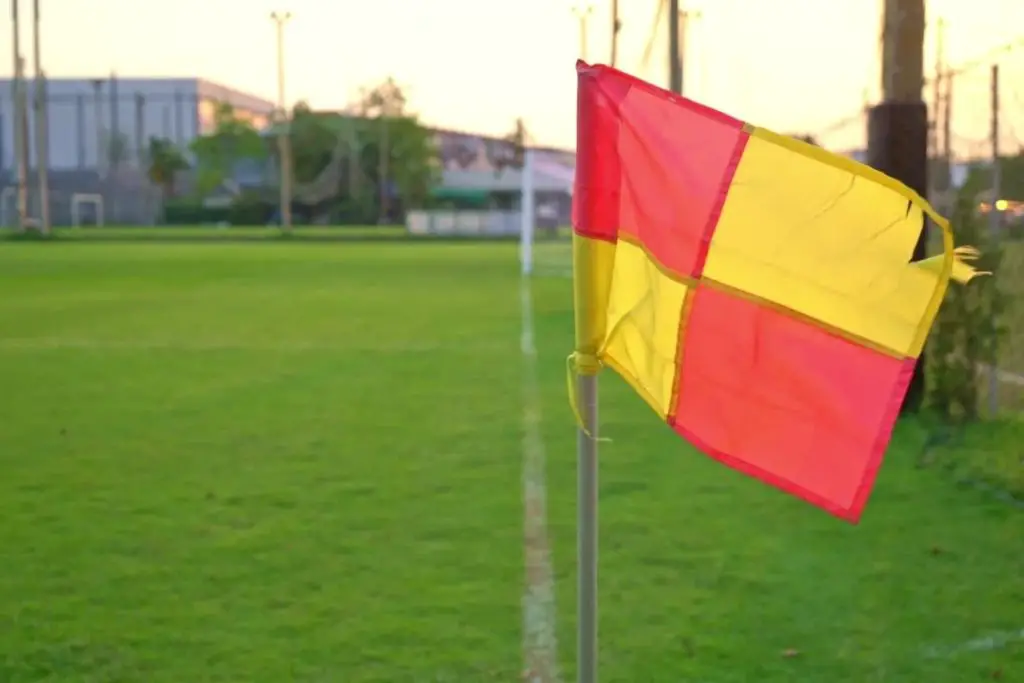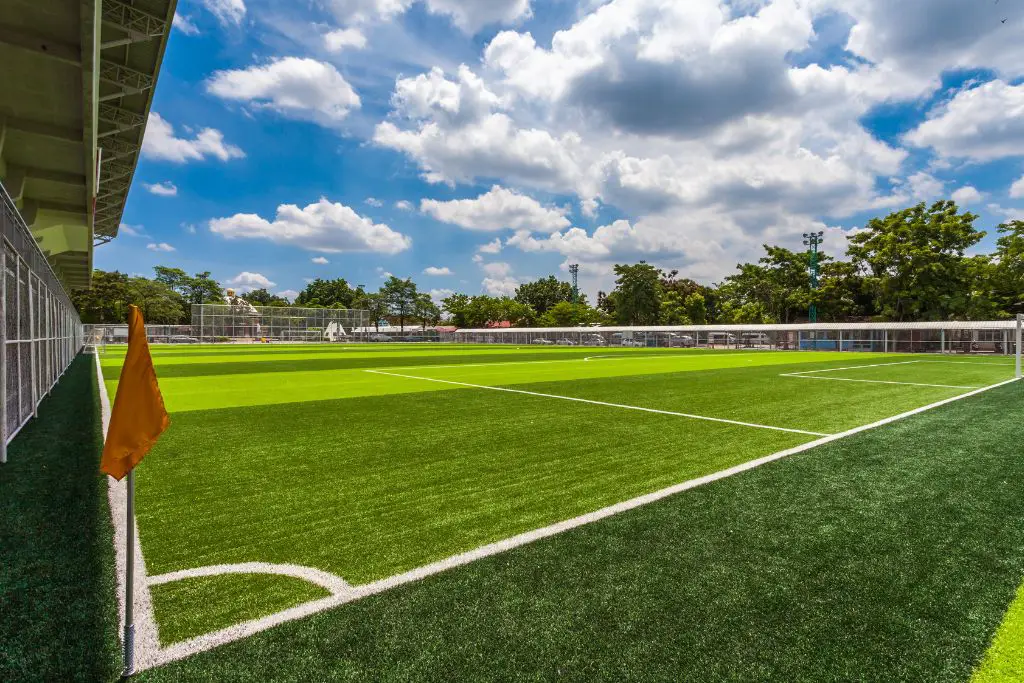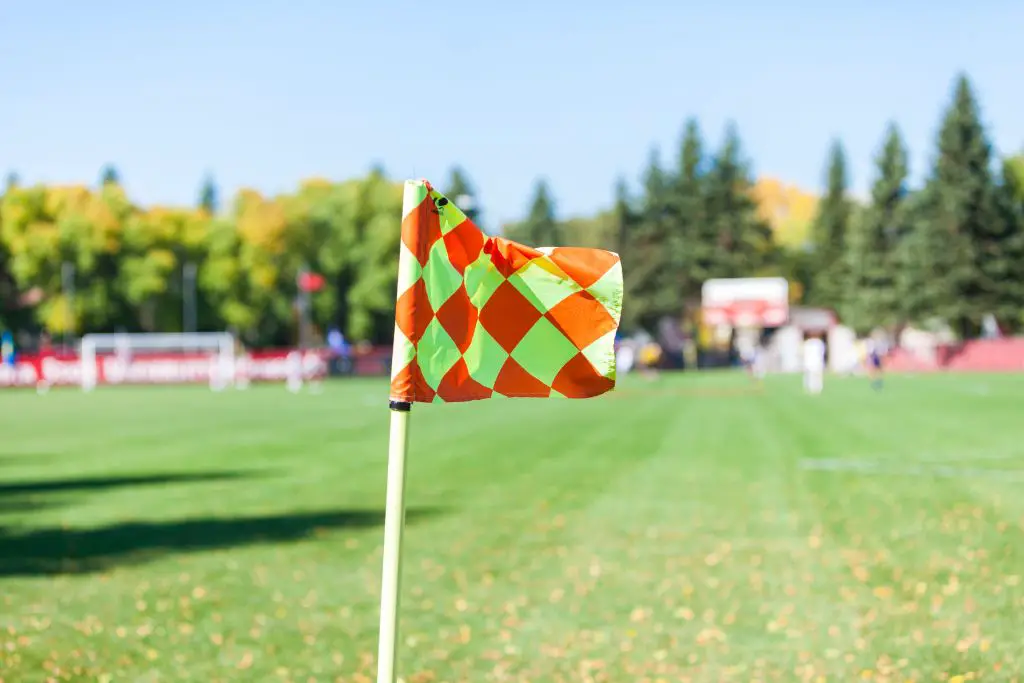As kids, many of us played soccer games on simple fields marked with lines, cones, and perhaps some buckets on sticks to serve as makeshift goals. But today, soccer rules make much more sense, and it’s easy to get lost in all of them, for instance, where the flags go on the field, what shapes and colors the flags should be, and so on. That said, where do flags go on a soccer field?
Flags on a soccer field are planted at the intersection between the extended goal line (the sideline) and the adjacent touchline. And although not so common today, some fields also have halfway flags located at least a meter off the touchline but directly in line with the half-line.
Today’s article sheds some light on a few basic laws about corner flags on a soccer field. We’ll also talk about their uses, where each flag should go, how they benefit the player, and answer other questions you may have about flags on a soccer field.
What Are the Flags in the Corner of the Field Called?

Flags in the corner of the field are simply called corner flags. They are also sometimes referred to as corner markers or corner posts. Corner flags can vary in color from red, blue, green, white, yellow, orange, green, or a combination of some of these colors.
We see corner flags on pitches at every professional and semi-pro soccer game because they are an essential part of the game. In fact, corner flags are compulsory according to many soccer laws laid out by major governing bodies.
Why Do Soccer Fields Have Flags?

Soccer fields have flags to help players and referees determine which line the ball crossed on its way out of play. Corner flags provide a visual reference for where the sidelines meet the endlines. This helps soccer players know what set piece they’ll take to bring the ball back into active play.
The corner flags are a crucial visual indicator in a soccer game. Referees and players use them to know how the ball will be brought back to play, either as a corner kick or a throw-in.
In case you’re unfamiliar with the terminology, set pieces are ways in which the ball should be brought back to play after a foul or when it goes out of play. Free kicks, corner kicks, and throw-ins are all set pieces in soccer. Any time the ball goes out of play, it’s a great opportunity for players to get creative with their attacking strategy.
The soccer ball can go out of play through the touchline or the end line (also called the goal line). When the ball goes out of play through the end line, the team that didn’t touch the ball last gets a corner kick. A player from that team places the ball on the corner mark and passes it to their teammate or kicks the ball directly inside the opponent’s penalty area.
If the ball goes out of play through either of the touchlines (also called sidelines), a player from the team that didn’t touch the ball last gets a throw-in. The corner flag enables the player, linesmen, the referee, and their assistant to determine where the ball went out of play. And since corner flags are part of the field, the ball can hit the corner flag and stay in play or go out of play through the end line or touchline.
However, if a ball hits any corner flags and remains inside a pitch, the game continues since there’s no need for a restart. The referee is responsible for making sure the game is played fairly. They watch the game from within the pitch and use the sidelines and touchlines to keep track of the game.
Are Corner Flags Optional in Soccer?

Corner flags mark the boundaries of the playing area on each of the corners, providing visual guidance to both the players and linesmen. One thing is for sure; corner flags are always present in every match. They are a standard part of the game that cannot be removed by the officials.
Corner flags aren’t optional in soccer. Major governing bodies like The FA dictate that corner flags are mandatory. These flags do much more than indicate how the ball will be brought back to play. Corner flags are also helpful in enabling players to determine the wind’s direction and strength.
Players can use this to their advantage when taking a corner kick. Corner kicks are a vital part of the game of soccer. These short set pieces allow players to plan an attack directly into the opponent’s penalty area. An avid soccer fan will tell you that properly executed corner kicks often result in a goal. And the player can use the wind’s direction and strength to their advantage.
For starters, the player should kick the ball hard slightly against the wind’s direction. As it descends into the penalty area, the wind “curves” it closer to the opponent’s goal post, where it’s easier to score.
Additional soccer rules state that corner flags should not have a pointed top and that they must be placed at every corner of the field. They should be made in bright colors to easily distinguish them from the surroundings. All corner flags should be fixed before the beginning of a game and aren’t to be removed during play.
Unlike corner flags, half-line flags are optional on any soccer field, and you probably won’t see them in major leagues.
How Tall Should the Corner Flags Be?
Safety comes first in soccer, and the corner flag posts are supposed to prioritize safety in their design. That includes their height. Soccer laws further state that corner flags shouldn’t be less than 5 feet or 1.5 meters high. The main reason for this height is to ensure that players don’t get hurt when they accidentally knock over the flag.
Short and firm corner flags may pose an enormous danger risk in case players accidentally fall on them. The materials used to make the flag posts should also not pose a danger to the players. They’re made of heavy-duty PVC with spring-loaded bases to absorb impact when players collide with them.
Additional rules suggest that the post should be 50mm (2in) or 30mm (1.2in) in diameter.
How Many Corner Flags on a Football Pitch

Every football pitch must have four corner flags. The soccer rule states that a corner flag is placed at every corner of the football pitch. Since soccer fields have four corners, every soccer pitch must have four corner flags.
Each of the corner flags is meant for the same purpose – to make the boundaries of the playing area more visible.
As you can see, corner flags are an essential part of the game. However, the rules governing the use of flags may vary from time to time, sometimes from league to league and sometimes from region to region. If you’re playing in a tournament or joining a new league, make sure you know their rules about flags and corner kicks at large before the game starts.
Final Thoughts
The corner flags are essential indicators on a soccer field. Each corner flag is placed in the corner at the end of the field and marks where the ball can go out of play. The corner flags are placed in the corners partly because corners are the most convenient place to refer to when determining where the ball goes out of play and what piece will be awarded to the team that didn’t touch the ball last.

